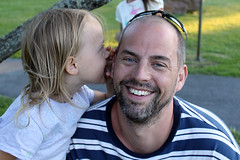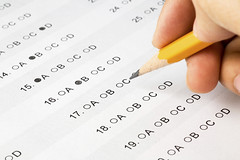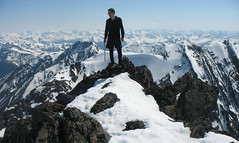| 6718158082 | space | geometric surface of the Earth | | 0 |
| 6718158083 | place | an area of bounded space of some human importance | | 1 |
| 6718158084 | region | a type of place | | 2 |
| 6718158085 | toponym | a place name | | 3 |
| 6718158086 | sequent occupancy | the succession of groups and cultural influences throughout a place's history | | 4 |
| 6718158087 | place-specific culture | ex. Sante Fe, Mexico, a complex mix of multiple Native American, Spanish colonial, and modern American influences based upon the sequence of past and current societal influences | | 5 |
| 6718158088 | scale | relationship of an object or place to the earth as a whole | | 6 |
| 6718158089 | map scale | describes the ratio of distance on a map and distance in the real world in absolute terms | | 7 |
| 6718158090 | relative scale | (AKA the scale of analysis) which describes the level of aggregation | | 8 |
| 6718158091 | level of aggregation | the level at which you group things together for examination | | 9 |
| 6718158092 | formal region | an area of bounded space that possesses some homogenous characteristic or uniformity | | 10 |
| 6718158093 | linguistic region | everyone speaks the same language, but can be very different culturally | | 11 |
| 6718158094 | culture region boundaries | The American "Dixie" south, fuzzy borders | | 12 |
| 6718158095 | political region boundaries | Boundary between countries, finite and well-defined | | 13 |
| 6718158096 | Environmental region boundaries | transitional and measurable | | 14 |
| 6718158097 | Ecotone | the environmental transition zone between two biomes | | 15 |
| 6718158098 | functional region | areas that have a central place (or node) that is a focus or point of origin that expresses some practical purpose, the influence of this point is strongest in the areas close to the center, and the strength of influence diminishes as distance increases from that point | | 16 |
| 6718158099 | market area | a type of functional region, home pro sport team example, more coverage and media in the city, diminishes as you move away | | 17 |
| 6718158100 | area of influence | outlet malls, shoppers travelling from longer distances but making a fewer number of trips | | 18 |
| 6718158101 | intervening opportunity | the shoppers who are "just passing through", who see a very brief intervening opportunity to do some discount shopping | | 19 |
| 6718158102 | vernacular region | based upon the perception or collective mental map of the region's residents | | 20 |
| 6718158103 | absolute location | defines a point or place on the map using coordinates such as latitude and longitude | | 21 |
| 6718158104 | relative location | refers to the location of a place compared to a known place or geographic feature, McLean and DC | | 22 |
| 6718158105 | Equator | 0 latitude | | 23 |
| 6718158106 | North and South Poles | 90 degrees latitude | | 24 |
| 6718158107 | Prime Meridian | 0 degrees longitude | | 25 |
| 6718158108 | International Date Line (sort of) | 180 degrees longitude | | 26 |
| 6718158109 | site | the physical characteristics of a place, such as the fact that NYC is located on a large, deep water harbor, next to the Atlantic ocean | | 27 |
| 6718158110 | situation | refers to the place's interrelatedness with other places, NYC and New England, port-of-call for Atlantic Circular Trade | | 28 |
| 6718158111 | absolute distance | in terms of linear units | | 29 |
| 6718158112 | relative distance | in terms of the degree of interaction between places or in units of time traveled | | 30 |
| 6718158113 | distance decay | means that the further away different places are from a place of origin, the less likely interaction will be with the original place | | 31 |
| 6718158114 | Tobler's Law | a principle that expresses relative distance, states that all places are interrelated, but closer places are more related than further ones | | 32 |
| 6718158115 | friction of distance | the increase in time and cost that usually comes with increasing distance | | 33 |
| 6718158116 | space-time compression | decresed time and relative distance between places | | 34 |
| 6718158117 | modes of transportation | airplanes, reduce travel time between two distant points, and as a result increase interaction | | 35 |
| 6718158118 | central places | any node of human activity | | 36 |
| 6718158119 | Central Place Theory | developed in the 1930s by the German geographer Walter Christaller, saw the economic world as an abstract spatial model, in which city location and the level of urban economic exchange could be analyzed using central places within hexagonal market areas, which overlapped each other at different scales | | 37 |
| 6718158120 | core and periphery | Mormon culture in Salt Lake City and the greater Western US | | 38 |
| 6718158121 | cluster | when things are grouped together | | 39 |
| 6718158122 | agglomeration | when clustering occurs purposefully around a central point or an economic growth pole | | 40 |
| 6718158123 | random pattern | when there is no rhyme or reason to the distribution of a spatial phenomenon | | 41 |
| 6718158124 | scaterred | objects that are normally ordered but appeared dispersed | | 42 |
| 6718158125 | linear | if the pattern is a straight line | | 43 |
| 6718158126 | sinuous | if the pattern is wavy | | 44 |
| 6718158127 | metes and bounds | |  | 45 |
| 6718158128 | township and range | based upon lines of latitude and longitude | | 46 |
| 6718158129 | arithmetic density | the number of things per square unit of distance | | 47 |
| 6718158130 | agricultural density | refers to the number of people per square unit of land actively under cultivation | | 48 |
| 6718158131 | physiologic density | measures the number of people per square unit of arable (being farmed or could be farmed) land | | 49 |
| 6718158132 | Expansion diffusion | the pattern originates in a central place and then expands outward in all directions to other locations | | 50 |
| 6718158133 | hierarchical diffusion | the pattern originates in a first order location then moves down to second-order locations and from each of these to subordinate locations at increasingly local scales | | 51 |
| 6718158134 | relocation diffusion | the pattern begins at a point of origin and then crosses a significant physical barrier, such as an ocean, mountain range, or desert, then relocates on the other side, often the journey can influence and modify the items being diffused | | 52 |
| 6718158135 | contagious | the pattern begins at a point of origin and then moves outward to nearby locations, especially those on adjoining transportation lines, this could be used to describe a disease but can also describe the movement of other things, such as news in rural regions | | 53 |
| 6718158136 | stimulus diffusion | here a general and underlying principle diffuses and then stimulates the creation of new products or ideas | | 54 |
| 6718158137 | topographic map | shows the contour lines of elevation, as well as the urban and vegetation surface with road, building, river, and other natural landscape features. These maps are highly accurate in terms of location and topography. They are used for engineering surveys and land navigation, especially in wilderness regions | | 55 |
| 6718158138 | thematic map | a number of different map types: chloropleth maps, isoline maps, dot density maps, flow-line maps, cartograms | | 56 |
| 6718158139 | chloropleth maps | express the geographic variability of a particular theme using color variations |  | 57 |
| 6718158140 | isoline maps | |  | 58 |
| 6718158141 | dot-density maps | |  | 59 |
| 6718158142 | flow-line maps | |  | 60 |
| 6718158143 | cartograms | |  | 61 |
| 6718158144 | equal-area projections | attempt to maintain the relative spatial science and the areas on the map, however these can distort the actual shape of polygons, such as the Lambert projections bending and squishing the northern Canadian islands to keep them at the same map scale as southern Canada on a flat sheet of paper |  | 62 |
| 6718158145 | conformal projections | attempt to maintain the shape of polygons on the map, the downside is that conformal projections can distort the relative area from one part of the map to the other, for instance, in the commonly used Mercator projection, the shape of Greenland is preserved, but it appears to be much larger in size than it actually is |  | 63 |
| 6718158146 | Robinson projection and Goode's homolosine projection | map projections that try to balance area and form, sacrificing a bit of both to create a more visually practical representation on the earth's surface |  | 64 |
| 6718158147 | model | an abstract generalization of real-world geographies that share a common pattern | | 65 |
| 6718158148 | spatial models | attempt to show the commonalities in pattern among similar landscpaes | | 66 |
| 6718158149 | urban models | try to show how different cities have similar spatial relationships and economic or social structures | | 67 |
| 6718158150 | non-spatial models | the demographic transition model, for instance, uses population data to construct a general model of the dynamic growth in national scale populations without reference to space | | 68 |
| 6718158151 | concentric zone model | cost-to-distance relationship in urban real estate prices, the resulting bid-rent curve explains why land prices are relatively low in suburban areas, but exponentially higher in the central business distrcit | | 69 |
| 6718158152 | gravity model | a mathematical model that is used in a number of different types of spatial analysis, used to calculate transportation flow between two points, determine the area of influence of a city's businesses, and estimate the flow of migrants to a particular place: Equation - (Location1Population x Location2Population)/Distance^2 | | 70 |
| 6718158153 | GIS | Geographical Information Systems, incorporate one r more data layers in a computer program capable of spatial analysis and mapping, data layers are numerical, coded, and textual data that is attributed to specific geographic coordinates or areas | | 71 |
| 6718158154 | GPS | Global Positioning Systems, utilize a network of satellites, which emit a measurable radio signal, when this signal is available from three or more Navstar satellites, a GPS receiver is able to triangulate a coordinate location and display map data for the user | | 72 |
| 6718158155 | Aerial photography and Satellite based remote sensing | make up a large-amount of the geographic and GIS data used today, aerial photographs are images of the earth from aircraft, printed on film, while remote sensing satellites use a computerized scanner to record data from the earth's surface, these data include not only visual light waverlengths, but also infrared and radar information | | 73 |















































































































































































































